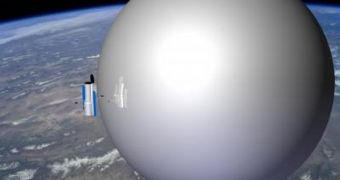At this point, launching a spacecraft – be it a space shuttle or a regular satellite – is a very risky business. Experts in charge of placing the vehicle in orbit need to calculate the risk of it being impacted by loose pieces of space junk, and that risk has gradually increased over the past decade. Many have argued about the need to clean Earth's orbit, but many of the approaches proposed thus far could make the matter worse. Now, a company proposes a new method of cleaning space junk that does not add to the severity of the situation.
Southern California-based Global Aerospace Corporation (GAC) says that its Gossamer Orbit Lowering Device (GOLD) is the best solution for the job. The idea was presented today, at the AIAA Astrodynamics Specialists Conference, held in Toronto, Canada. Speaking at the Natural Space Debris session, expert Dr. Kristin L. Gates underlined some of the challenges and possibilities associated with the GOLD mission to low-Earth orbit (LEO).
The scientist explains that GOLD functions on a rather simple scientific principle. The device employs a very large, ultra thin balloon, which it envelopes around a targeted piece of space debris. As this happens, the aerodynamic drag of that shard is increased by a factor of several hundred, a fact that significantly changes its altitude and course. The object naturally ends up crashing into the planet's atmosphere, where it burns up. It is also estimated that GOLD will be able to reduce the in-orbit life time of some particularly troublesome pieces of junk from centuries to only a few months.
The system might actually work, critics believe, due to the simple nature of the principle on which it relies for its effect. It takes only a small amount of material to produce the thin balloon, and a minute amount of gas for inflating it into a perfect sphere. This is difficult to achieve back on Earth, where the force of gravity and the planet's atmosphere both exert individual pressures on a balloon. But in space there are no such constraints. As such, GOLD could be attached to all satellites with only a small additional cost. The long term benefits outweigh a potential higher construction cost, experts argue, especially when the end result is keeping Earth's orbit clean.

 14 DAY TRIAL //
14 DAY TRIAL //